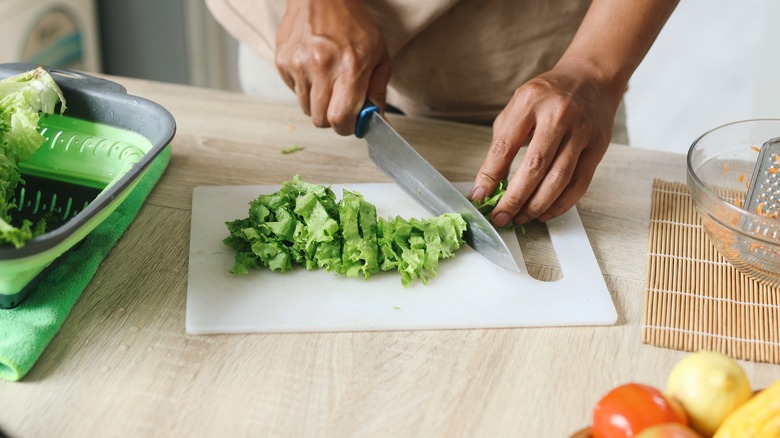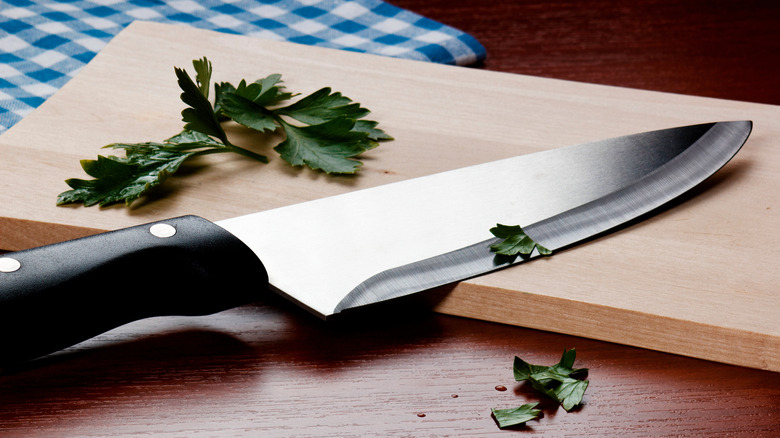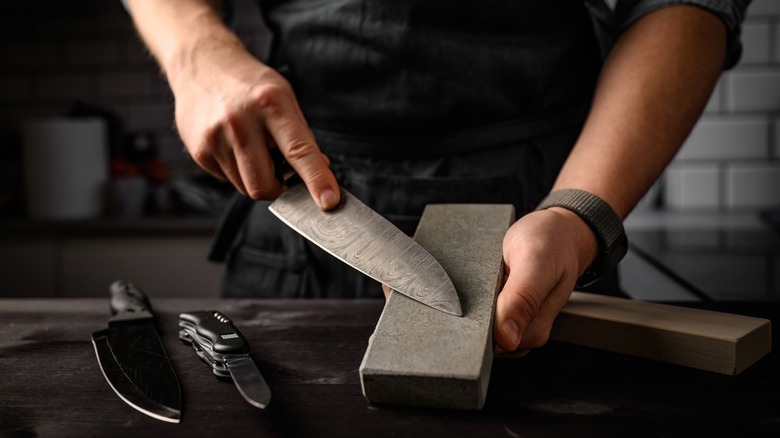Why You Need To Sharpen Your Knife Before Making Salads
You won't get far in the kitchen without a knife, especially if it's not sharp. A dull blade can make chopping veggies more difficult and dangerous, as it requires more pressure to cut through ingredients. The added force can lead to accidents, of course, but it can also diminish the flavor of a dish. This is particularly true for salads. Whether you're preparing a classic Caesar or a protein-packed Cobb, a knife that's overdue for sharpening could spell disaster for the taste and texture of some salad ingredients.
While tossing together an assortment of leafy greens and toppings might seem simple enough, how you handle your produce greatly impacts the final product. This is one of the reasons why restaurant salads are so hard to recreate at home. As it turns out, the mere act of cutting vegetables can change their flavor and appearance for the worse. The harsh physical change often triggers a chemical self-defense mechanism, increasing production of polyphenols, compounds responsible for various biological processes in plants. Chances are you've encountered this in the kitchen. Slicing into an avocado's flesh, for instance, can cause it to turn an unappetizing shade of brown. But even lettuce can develop a slimy texture when its leaves are damaged from rough chopping. Similarly, herbs may lose some of their signature fragrance and flavor. So, if you notice some of your salad's ingredients are bruised or bland by the time they end up in your bowl, your knife is probably the prime suspect.
A dull knife can harm a salad's flavor and texture
Chopping up a head of lettuce is a necessary evil for transforming large leaves into perfect bite-sized pieces. But when veggies are wounded, they undergo a series of chemical changes. NPR reports that while more polyphenols are generally good from a nutritional standpoint, they can make certain produce unsavory. Some vegetables develop a bitter taste to ward off picky eaters, while others change color as the damaged cells oxidize or absorb moisture. For instance, lettuce can start to turn pink, or "rust," after being cut.
While these changes are impossible to completely avoid when making a salad, your knife's sharpness can affect how serious the injury to produce is. Ingredients like lettuce and herbs warrant extra care when it comes to salad prep. If they end up severely bruised or crushed, they'll likely wilt or lose their flavor. With a sharp chef's knife, you can achieve quick, precise cuts and avoid applying excessive force to fragile produce, protecting the plant cells from unnecessary damage.
Choosing the right knife or cutting technique can also play a role in preserving produce's appetizing features. Ceramic or plastic-bladed knives are best for slicing avocados, as metal can speed up browning. Gordon Ramsay's stacking method for chopping basil is also effective for avoiding accidentally bruising the delicate herb. No matter the type of knifework you employ, though, your best bet is to sharpen any dull blades so you don't butcher your salad veggies.
Other signs your knife is overdue for sharpening
Determining when exactly it's time to sharpen your knives isn't so straightforward. Considering that maintaining them is one of the secrets chefs learn in culinary school, it's natural that home cooks might not know what clues to look for. To complicate things further, there's no one answer to fit all situations. A few factors could either speed up or slow down your knife-sharpening timeline, from how much you use the blades to their quality. However, there are a couple of good rules of thumb worth considering when you're wondering how often to sharpen your knives.
Besides the salad woes related to bruised lettuce or bland, less-bright herbs, other parts of your prep-work can serve as good indicators. If you normally use a non-serrated knife to cut tomatoes and notice that they're ending up crushed, leaving a watery mess behind on your cutting board, chances are the blade is no longer sharp enough. The same goes for instances in which you've had to saw through bell peppers or use both hands to chop a carrot into bite-sized coins. Of course, there are other ways to confirm a knife's dullness that don't involve putting produce to the test, from (carefully!) checking the blade's tackiness with your thumb to trying to slice through a sheet of paper. Once you know your knife needs sharpening, though, you'll be on your way to saving time in the kitchen and cooking up more appetizing dishes — salads included.


